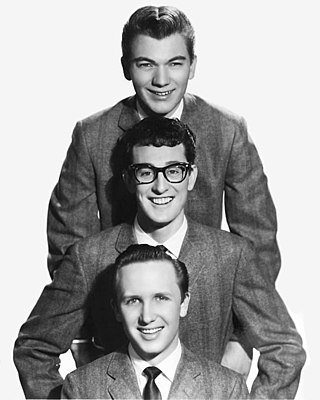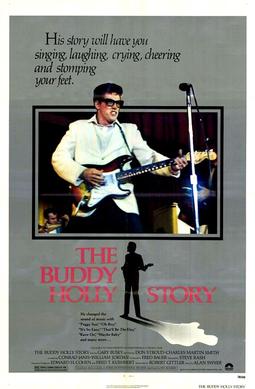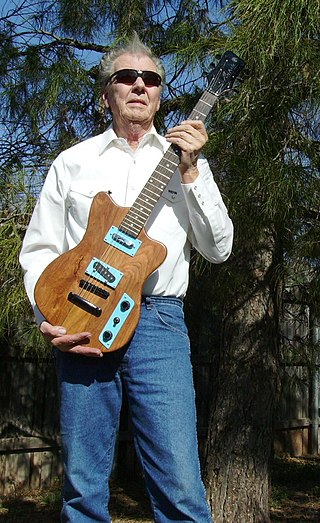
Charles Hardin Holley, known as Buddy Holly, was an American singer and songwriter who was a central and pioneering figure of mid-1950s rock and roll. He was born to a musical family in Lubbock, Texas, during the Great Depression, and learned to play guitar and sing alongside his siblings. Holly's style was influenced by gospel music, country music, and rhythm and blues acts, which he performed in Lubbock with his friends from high school.

Waylon Arnold Jennings was an American singer, songwriter, musician, and actor. He is considered one of pioneers of the outlaw movement in country music.

The Crickets were an American rock and roll band from Lubbock, Texas, formed by singer-songwriter Buddy Holly in January 1957. Their first hit record, "That'll Be the Day", released in May 1957, peaked at number three on the Billboard Top 100 chart on September 16, 1957. The sleeve of their first album, The "Chirping" Crickets, shows the band line-up at the time: Holly on lead vocals and lead guitar, Niki Sullivan on rhythm guitar, Jerry Allison on drums, and Joe B. Mauldin on bass. The Crickets helped set the template for subsequent rock bands, such as the Beatles, with their guitar-bass-drums line-up, performing their own self-written material. After Holly's death in 1959 the band continued to tour and record into the 1960s and beyond with other band members through to the 21st century.

Lubbock is the 10th-most populous city in the U.S. state of Texas and the seat of government of Lubbock County. With a population of 263,930 in 2022, the city is also the 85th-most populous in the United States. The city is in the northwestern part of the state, a region known historically and geographically as the Llano Estacado, and ecologically is part of the southern end of the High Plains, lying at the economic center of the Lubbock metropolitan area, which had an estimated population of 328,283 in 2022.

The Buddy Holly Story is a 1978 American biographical musical drama film directed by Steve Rash which tells the life and career of rock and roll musician Buddy Holly. It features an Academy Award-winning musical score, adapted by Joe Renzetti and Oscar-nominated lead performance by Gary Busey. The film also stars Don Stroud, Charles Martin Smith, Conrad Janis, William Jordan, and Maria Richwine, who played Maria Elena Holly.
María Elena Holly is the widow of American rock and roll pioneer Buddy Holly. As a receptionist at Peermusic, she met with Holly and his band the Crickets on June 19, 1958, and Holly proposed to her after five hours on their first date. Less than two months later, the couple married on August 15, 1958, in Lubbock, Texas. On February 3, 1959, Buddy Holly died in a plane crash along with fellow musicians Ritchie Valens and The Big Bopper near Clear Lake, Iowa. She suffered a miscarriage the following day and could not attend Holly's funeral in Lubbock.

Jerry Ivan Allison was an American musician. He was best known as the drummer for the Crickets and co-writer of their hits "That'll Be the Day" and "Peggy Sue", recorded with Buddy Holly. His only solo chart entry on the Billboard Hot 100 was "Real Wild Child", issued in 1958 under the name Ivan. Allison was inducted into the Rock and Roll Hall of Fame in 2012.

Joseph Benson Mauldin, Jr. was an American bassist, songwriter, and audio engineer who was best known as the bassist for the early rock and roll group the Crickets. Mauldin initially played a double (standup) bass, then switched to a Fender Precision Bass guitar. After several years with the Crickets, he became a recording engineer at Gold Star Studios, the Los Angeles studio which became the "hit factory" for Phil Spector, Brian Wilson, and other major 1960s rock performers.
Jack Huddle (1928–1973) was an American rockabilly musician and songwriter. He performed and recorded with Buddy Holly early in Holly's career.
"Anything You Can Do (I Can Do Better)" is a show tune composed by Irving Berlin for the 1946 Broadway musical Annie Get Your Gun. The song is a duet, with one male singer and one female singer attempting to outdo each other in increasingly complex tasks.
Niki Sullivan was an American rock and roll guitarist, born in South Gate, California. He was one of the three original members of Buddy Holly's backing band, the Crickets. Though he lost interest within a few months of his involvement, his guitar playing was an integral part of Holly's early success. He performed on 27 of the 32 songs Holly and The Crickets recorded over his brief career. He co-wrote a number of his own songs. In 2012, Sullivan was inducted into the Rock and Roll Hall of Fame as a member of the Crickets by a special committee, aimed at correcting the mistake of not including the Crickets with Buddy Holly when he was first inducted in 1986.

Gary P. Nunn is an American country music singer-songwriter. He is best known for writing "London Homesick Blues", which was the theme song for Austin City Limits from 1977 to 2004. Nunn is also considered the father of the progressive country scene that started in Austin in the early 1970s.

Buddy: The Buddy Holly Story is a musical in two acts written by Alan Janes, and featuring the music of Buddy Holly. It opened at London's Victoria Palace Theatre on 12 October 1989. An early example of the jukebox musical, Buddy ran in London's West End for over 12 years, playing 5,140 performances. Janes took over the producing of the show himself in 2004, and Buddy has been on tour extensively in the UK since then, having played Broadway, five U.S. National Tours and numerous other productions around the world. The show was nominated for an Olivier Award for Best Musical.

"Everyday" is a song written by Buddy Holly and Norman Petty, recorded by Buddy Holly and the Crickets on May 29, 1957, and released on September 20, 1957, as the B-side of "Peggy Sue", which went to three on the Billboard Top 100 chart in 1957. The song is ranked number 238 on Rolling Stone magazine's list of the "500 Greatest Songs of All Time".

Joseph Sonny West was an American songwriter and musician, best known as the co-writer of two of Buddy Holly's biggest hits: "Oh, Boy!" and "Rave On".
The Picks was an American vocal quartet that backed Buddy Holly and the Crickets' band on nine of the first twelve Crickets releases on Brunswick in 1957, as well as backing Buddy Holly solos for group sounds. The original members were John Pickering (lead), Bill Pickering (tenor), and Bob Lapham (baritone).
Jerry Naylor Jackson was an American country and rock and roll artist, broadcaster and inspirational speaker. From late 1961 through 1964 he was The Crickets' lead vocalist.
Harold David Box was an American rock and roll musician in the early 1960s. Box was influenced by fellow Texan Buddy Holly, and even took his place as singer of his group, The Crickets, for a short time after Holly's death. Box also collaborated with Roy Orbison, and found local success with his own group, the Ravens.
The Lubbock Symphony Orchestra (LSO) is an orchestra based in Lubbock, Texas, and is one of the oldest community organizations in the region. The orchestra is composed of professional musicians from all parts of the Lubbock community. The orchestra currently performs at Lubbock Memorial Civic Center Theatre but will relocate to the Buddy Holly Hall of Performing Arts and Sciences following the hall's completion. The ensemble is led by David Cho, the orchestra's seventh music director, who has been with the orchestra since 2012.

The Buddy Holly Center is a performance and visual arts center in Lubbock, Texas, dedicated to Buddy Holly as well as the music of Lubbock and West Texas more broadly. The building in which it is located opened as the city's Fort Worth and Denver South Plains Railway depot in 1928. In 1996, the City of Lubbock obtained a sizable collection of Holly-related artifacts from his estate, and the next year it purchased the former depot. In 1999, the new Buddy Holly Center opened as the home of the newly acquired Buddy Holly collection as well as a replacement for the city's Fine Arts Center, which had been established in 1984.

















